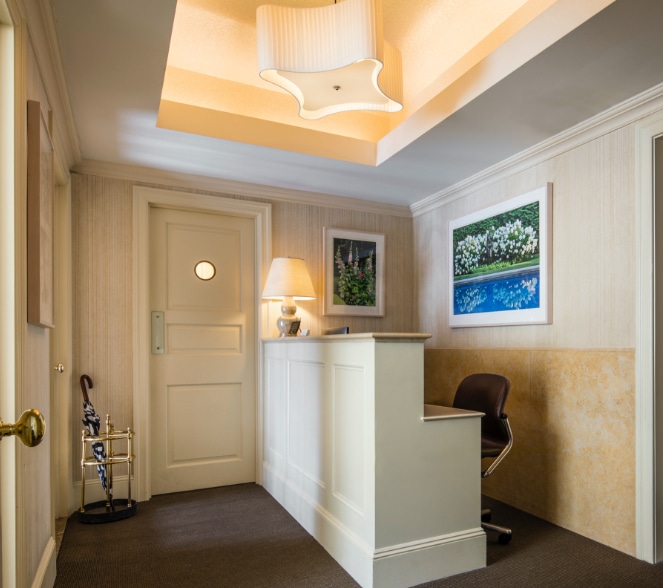What is the Goal of Eyelid Surgery?
The goal of aesthetic eyelid surgery is to restore a fresh appearance to the upper face. The optimal surgical plan will produce a clean and fresh look to the eyes without actually changing their expression or shape. A less tired look results without telltale signs of surgery.
How is this accomplished?
Rejuvenation of the eye area is achieved by performing one or more of the following procedures: removing excess upper eyelid skin and fat, removing excess lower eyelid fat, repositioning lower eyelid fat to eliminate circles, and removing excess lower eyelid skin. Adjunctive procedures include smoothing the lower eyelid skin texture with a chemical peel, tightening the lower eyelids if they are loose, removing the muscles that cause vertical furrows between the eyebrows, and lifting the eyebrows. Each component procedure adds benefit when it is indicated.
Who is a candidate for eyelid surgery?
Aging changes begin around the eyes in the mid-thirties. Most women become candidates for eyelid surgery in their early forties and men about ten years later. A common early complaint in women is wrinkled upper eyelid skin that looks aging and interferes with makeup application. Men also complain of heavy upper eyelids but usually not until much later in life. Both men and women are troubled by bags and circles under the eyes. Sometimes loose or darkened skin contributes to the problem. All of these issues can usually be effectively addressed by surgery.
Do I need both my upper and lower eyelids done?
Early candidates for upper eyelid surgery frequently do not need their lower eyelids done at the same time. On the other hand, young individuals without upper eyelid aging changes that have hereditary lower eyelid bags and circles will benefit from lower eyelid surgery alone. Older patients usually exhibit aging changes in both the upper and lower eyelids that warrants a combined procedure. Doing one without the other in this setting often makes the untreated area more apparent by comparison afterwards.
Where are the incisions used in eyelid surgery?
Upper eyelid incisions are placed within the natural eyelid crease (Figure 1). The scars are not visible with the eyes open. They are permanent, like all scars, but are typically very subtle after healing is complete. Lower eyelid surgery that just involves fat bag treatment does not require a visible external incision. The fat is accessed through an incision on the inside of the eyelid. If there is loose lower eyelid skin then an incision just under the eye lashes is used to tighten it (Figure 1). This incision also heals extremely well and is eventually difficult to detect.

What is a browlift?
Sometimes upper eyelid hooding is due primarily to sagging eyebrows. This condition is best treated with a combination of upper eyelid surgery and a browlift. Although a browlift is more involved than eyelid surgery it will contribute to producing a better and more natural result than the alternative of more radical removal of excess upper eyelid skin alone. Browlifts establish a natural arch to the outer part of the eyebrow and reveal the pleasing curve of the outer orbital rim in women (Figure 2).

Browlifts are accomplished either with a small scar method or with the traditional long scar through the scalp at the top of the head. The former method is performed through a half inch scalp incision just above the hairline on each side, usually in conjunction with upper eyelid incisions used to remove excess upper eyelid skin. The forehead skin is loosened, lifted, and then fixed in place with the aid of small dissolvable anchors set into the bone underneath (Figure 3). The latter method is called an “open” browlift. It is reserved for those usually over 60 years old that have more advanced sagging of the forehead. The long scalp incision extending over the top of the head reaches almost from ear to ear. This procedure removes a strip of scalp skin to tighten the forehead. Hair loss adjacent to the incision and scalp numbness can occur but are uncommon and usually minor in scope. It is not necessary to remove any hair to perform either type of browlift.
The small scar method (also referred to as an endoscopic browlift), while more popular and palatable as a choice, does not produce long-lasting results. A partial benefit remains from removing the upper eyelid skin at the same time but the eyebrow position typically returns to where it was before surgery. Therefore experience has demonstrated that this method is not a good choice for lifting the eyebrows. Instead, the traditional, open method is needed if eyebrow elevation is a priority.

What about temple lifts and fat graft methods?
Temple lifts are supposed to raise the ends of the eyebrows through an incision hidden in the temple area scalp. They are far less invasive than a traditional open browlift and are simple to perform. However, the pull with this technique is in an oblique rather than vertical direction, thereby reducing its efficacy. Temple lifts typically produce very subtle results that do not last long.
Fat grafts harvested from another part of the body can be injected under the eyebrows to increase fullness and raise them slightly. Results can look pleasing in properly selected patients when the fat is placed artistically. However, fat graft survival is unpredictable and the results often diminish greatly within six months.
Do I need a browlift?
Fortunately, the majority of women with aging changes around the eyes do not need a browlift. Approximately 10 percent will benefit. Men need it even more rarely. It is restricted to severe conditions in men because browlifts tend to be feminizing.
What about the heaviness between my eyes?
Some individuals have deep vertical furrows between their eyebrows and heaviness of the inner eyebrows that together convey an angry look. This is due to chronic overactivity of the small “corrugator” muscles located underneath the inner part of the eyebrows (Figure 4 - left). This area can be effectively smoothed out by using injectable paralytic agents such as BOTOX, Dysport, and others. These injections must be repeated every four to six months to maintain the effect. They are therefore incrementally expensive.

A more permanent alternative is to remove portions of these muscles surgically. This can be accomplished through an upper eyelid incision at the same time as eyelid skin removal, or as part of a browlift (Figure 4 - right). There is no significance to removing parts of these small muscles beyond the fact that it prevents making an angry expression. Some function will still remain in any event.
What nonsurgical techniques are available to make my eyes look better?
Surgery only improves eyelid appearance in repose. Heavy wrinkling produced by strong expression, such as “crow’s feet” at the corners of the eyes, can be effectively treated with the paralytic injectable agents described above.
Crepey lower eyelid skin exhibiting fine wrinkles in repose can be improved by using a dilute trichloroacetic acid (TCA) chemical peel. This method removes the top layer of skin. The deeper layers then regenerate a new epidermis that is smoother and softer in appearance. A before and after example is shown in Figure 5. Light crusting is present for about one week and then the skin remains pink for several weeks. Make-up effectively conceals discoloration during the healing process. Dark lower eyelid skin color can also be treated with a TCA peel but the results are more variable.

Injectable filler materials such as Restylane and Juvederm are made from hyaluronic acid, a normal substance found in the body. These agents can be used to fill in hollow lower eyelids. This is a worthwhile approach in the younger patient having minimal indications for surgery. While effective in expert hands, it can leave lumps, make the eyelids appear puffy if overdone, and result in discoloration if placed too superficially. Fortunately these problems can be reversed with a dissolving agent. Rarely however, chronic lower eyelid swelling from injectables is permanent and unresponsive to any type of treatment. Injectables are also temporary, and like paralytic agents, can be incrementally expensive.
What are dry eyes?
Some individuals have either decreased tear production or other physiologic defects that result in dry eye symptoms. These symptoms include eye irritation, itching, and paradoxically, watery eyes. This condition often develops with age. Eyelid surgery can produce these symptoms in unaffected but prone individuals, or worsen established symptoms. Those with suggestive symptoms should be seen by an ophthalmologist and tested prior to surgery.
Surgery can be performed conservatively in those with minimal dry eye symptoms but is not recommended in others more severely afflicted. It may be necessary to perform upper and lower eyelid surgery in two separate stages for maximum safety in patients with borderline dry eye symptoms. LASIK procedures performed to improve vision can also contribute to eye dryness and compound the effects of aesthetic eyelid surgery on dry eye symptoms.
What is lower eyelid malposition?
Older individuals with weak lower eyelids and younger individuals with very prominent eyes may exhibit drooping, or malposition, of the lower eyelids (Figure 6). Lower eyelid malposition imparts a sad look to the eyes but more importantly may cause dry eye symptoms due to corneal exposure. Irritation of the eyes can result because the lower eyelid moves away from the eye, promoting dryness and interfering with tear drainage. Removing skin from the lower eyelids typically makes this condition worse, sometimes requiring corrective surgery.

There is a procedure called canthopexy that treats this problem by tightening the lower eyelid. This is often included as part of the surgical plan in patients with weak lower eyelids or established malposition. The corner of the eye is repositioned higher to restore lower eyelid tone and position. There is normally a temporary upward tilt to the outer part of the eye that resolves after about one month.
What are malar bags?
Malar bags are small puffy areas sometimes seen on the cheekbone below the lower eyelid. They randomly occur in some individuals and often appear worse on one side. Unfortunately, there is no effective treatment for malar bags and they persist after successful lower eyelid surgery.
How long do the benefits of surgery last?
The beneficial effects of eyelid surgery last for decades. Browlifts rarely need to be repeated. While some develop small amounts of additional excess upper eyelid skin after many years, most patients have only one operation and remain pleased.
Where is the surgery performed and how long does it take?
Eyelid and browlift surgery is performed in the office as an outpatient procedure. Operating time correlates with the scope of the procedure, both reflecting the severity of the aging changes. Upper eyelid surgery requires about 30 minutes. Including a browlift adds an hour and a half. Lower eyelid surgery ranges up to one hour.
Removing corrugator muscles with upper eyelid surgery or performing a lower eyelid chemical peel does not add significant time to the procedure. However, tightening of the lower eyelids, if necessary, adds 45 minutes. All surgery is performed entirely by Dr. Hidalgo.
What type of anesthesia is used?
Surgery is usually performed with deep intravenous sedation combined with local anesthesia, or general anesthesia. There is no awareness in either case. A board certified anesthesiologist is present for the entire procedure and uses state-of-the-art monitoring equipment.
What are the risks associated with eyelid and browlift surgery?
Eyelid and brow surgery are seldom associated with complications and are among the safest aesthetic procedures performed. The most common complication is a hematoma, occurring in about one percent. A hematoma is an accumulation of blood that forms a lump under the skin. It usually requires removal in the operating room but does not adversely affect either short-term recovery or the long-term result. However, a hematoma occurring deep within the orbit can threaten vision and requires prompt treatment. Fortunately this is an exceedingly rare event. Other problems such as infection, eye irritation, delayed healing or excessive scarring are possible but unusual. Weak lower eyelids can droop after surgery and may require a corrective procedure.
Patients prone to dry eye symptoms may experience worsening of their symptoms after surgery. This is usually temporary but in more extreme cases can be permanent. Corrugator muscle excision and browlifts can cause numbness of the forehead and parts of the scalp. Limited hair loss can occur adjacent to browlift scalp incisions but this usually resolves over time. The hair line may be shifted noticeably higher with browlifts. The vast majority of patients do not have any complications from eyelid and forehead surgery.
Why is smoking so harmful for surgery?
Smoking severely reduces blood supply to the skin and also delays healing. It is therefore essential to stop smoking completely for at least three weeks before surgery and six weeks after. Simply cutting back is not enough. Nicotine containing patches and gum are equally harmful.
What is the recovery like?
Patients leave the office without any bandages. Cool compresses are placed over the eyes for the first twenty-four hours. It is not necessary to stay in bed. Vision is usually slightly blurred due to swelling and eye ointment used during surgery. This usually resolves in a few days. Most patients describe having low grade discomfort only. The corners of the eyes are sometimes painful for a few days in those requiring a lower eyelid tightening procedure. Browlifts usually feel tight due to swelling. Portions of the forehead and scalp may also feel numb following either a browlift or corrugator muscle excision but this eventually resolves.
Eyelid stitches are removed by six days. Regular eye glasses hide much of the bruising after a week. Most of the swelling and discoloration is gone by two weeks. A light cover-up may be applied to the lower eyelids beginning one week after surgery, or by two weeks if a chemical peel has also been performed. For women, other facial and eyelid makeup including mascara, eye shadow, and eyeliner may be conservatively applied beginning one week after surgery.
Flying and driving are not recommended for two weeks. Walking outdoors can begin after a few days, weather permitting. Mild cardiovascular exercise without impact such as a stationary bike can begin at two weeks. It is best to wait as long as six weeks before resuming more intense exercise and activities such as jogging, weightlifting, ball sports, yoga, pilates, skiing, and horseback riding.
What are some of the limitations associated with eyelid and forehead surgery?
There are pre-existing conditions that can adversely influence surgical outcomes. These include poor skin elasticity, heavy wrinkling, severe sun damage, deep lower eyelid hollows, very prominent eyes, very dark lower eyelid skin color, weak lower eyelid tone, previous eyelid surgery, previous injections with fat or other substances, and a history of dry eye symptoms. Thin hair and a high hairline can limit browlift options. The best surgical effort will likely achieve a more modest result in the presence of one or more of these factors.
What are the costs involved in having surgery?
There are separate fees for surgery, anesthesia, and operating room use. Costs also include preoperative lab tests and medical grade photographs. Private duty nurses are not typically necessary following eyelid and browlift surgery.
What are the steps involved in proceeding with surgery?
At the initial consultation your eyelids and forehead will be evaluated and a surgical plan proposed, provided that you are a good candidate for the procedure. Once the plan is agreed upon a surgical date can be scheduled. Photographs and preoperative laboratory studies follow. Patients with significant medical conditions will need to obtain clearance from their internist or other specialist beforehand.




